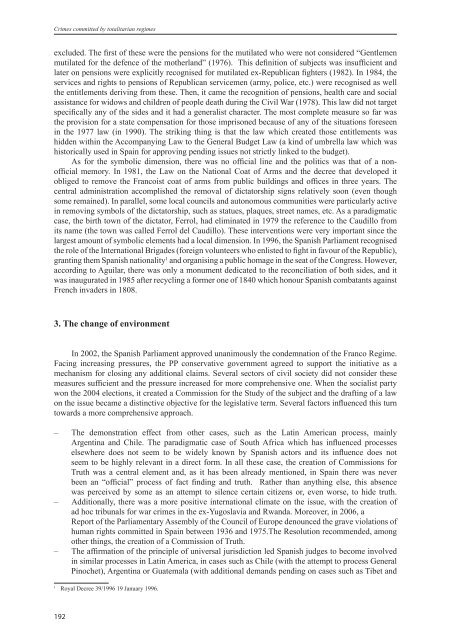crimes committed by totalitarian regimes - Ministrstvo za pravosodje
crimes committed by totalitarian regimes - Ministrstvo za pravosodje
crimes committed by totalitarian regimes - Ministrstvo za pravosodje
You also want an ePaper? Increase the reach of your titles
YUMPU automatically turns print PDFs into web optimized ePapers that Google loves.
Crimes <strong>committed</strong> <strong>by</strong> <strong>totalitarian</strong> <strong>regimes</strong><br />
excluded. The first of these were the pensions for the mutilated who were not considered “Gentlemen<br />
mutilated for the defence of the motherland” (1976). This definition of subjects was insufficient and<br />
later on pensions were explicitly recognised for mutilated ex-Republican fighters (1982). In 1984, the<br />
services and rights to pensions of Republican servicemen (army, police, etc.) were recognised as well<br />
the entitlements deriving from these. Then, it came the recognition of pensions, health care and social<br />
assistance for widows and children of people death during the Civil War (1978). This law did not target<br />
specifically any of the sides and it had a generalist character. The most complete measure so far was<br />
the provision for a state compensation for those imprisoned because of any of the situations foreseen<br />
in the 1977 law (in 1990). The striking thing is that the law which created those entitlements was<br />
hidden within the Accompanying Law to the General Budget Law (a kind of umbrella law which was<br />
historically used in Spain for approving pending issues not strictly linked to the budget).<br />
As for the symbolic dimension, there was no official line and the politics was that of a nonofficial<br />
memory. In 1981, the Law on the National Coat of Arms and the decree that developed it<br />
obliged to remove the Francoist coat of arms from public buildings and offices in three years. The<br />
central administration accomplished the removal of dictatorship signs relatively soon (even though<br />
some remained). In parallel, some local councils and autonomous communities were particularly active<br />
in removing symbols of the dictatorship, such as statues, plaques, street names, etc. As a paradigmatic<br />
case, the birth town of the dictator, Ferrol, had eliminated in 1979 the reference to the Caudillo from<br />
its name (the town was called Ferrol del Caudillo). These interventions were very important since the<br />
largest amount of symbolic elements had a local dimension. In 1996, the Spanish Parliament recognised<br />
the role of the International Brigades (foreign volunteers who enlisted to fight in favour of the Republic),<br />
granting them Spanish nationality 1 and organising a public homage in the seat of the Congress. However,<br />
according to Aguilar, there was only a monument dedicated to the reconciliation of both sides, and it<br />
was inaugurated in 1985 after recycling a former one of 1840 which honour Spanish combatants against<br />
French invaders in 1808.<br />
3. The change of environment<br />
In 2002, the Spanish Parliament approved unanimously the condemnation of the Franco Regime.<br />
Facing increasing pressures, the PP conservative government agreed to support the initiative as a<br />
mechanism for closing any additional claims. Several sectors of civil society did not consider these<br />
measures sufficient and the pressure increased for more comprehensive one. When the socialist party<br />
won the 2004 elections, it created a Commission for the Study of the subject and the drafting of a law<br />
on the issue became a distinctive objective for the legislative term. Several factors influenced this turn<br />
towards a more comprehensive approach.<br />
– The demonstration effect from other cases, such as the Latin American process, mainly<br />
Argentina and Chile. The paradigmatic case of South Africa which has influenced processes<br />
elsewhere does not seem to be widely known <strong>by</strong> Spanish actors and its influence does not<br />
seem to be highly relevant in a direct form. In all these case, the creation of Commissions for<br />
Truth was a central element and, as it has been already mentioned, in Spain there was never<br />
been an “official” process of fact finding and truth. Rather than anything else, this absence<br />
was perceived <strong>by</strong> some as an attempt to silence certain citizens or, even worse, to hide truth.<br />
– Additionally, there was a more positive international climate on the issue, with the creation of<br />
ad hoc tribunals for war <strong>crimes</strong> in the ex-Yugoslavia and Rwanda. Moreover, in 2006, a<br />
Report of the Parliamentary Assembly of the Council of Europe denounced the grave violations of<br />
human rights <strong>committed</strong> in Spain between 1936 and 1975.The Resolution recommended, among<br />
other things, the creation of a Commission of Truth.<br />
– The affirmation of the principle of universal jurisdiction led Spanish judges to become involved<br />
in similar processes in Latin America, in cases such as Chile (with the attempt to process General<br />
Pinochet), Argentina or Guatemala (with additional demands pending on cases such as Tibet and<br />
1<br />
Royal Decree 39/1996 19 January 1996.<br />
192




